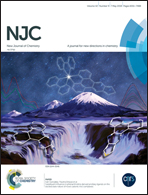Symmetrical and dissymmetrical 2,2′-bis-dipyrrin ligands and Zn(ii) binuclear helicates†
Abstract
A strategy for the synthesis of symmetrical and dissymmetrical 2,2′-bisdipyrrin ligands is proposed. It relies on the preparation of derivatives bearing at their periphery reactive groups that are subsequently used for the introduction of functional units leading to a wide range of new ligands. This approach was applied to the carboxylic acid unit and its subsequent transformation into amides using aniline and an aminopyridine derivative. A series of symmetrical and dissymmetrical species has thus been synthesized and characterized in solution as well as in the crystalline state by X-ray diffraction for some of them. Furthermore, the formation of binuclear helicates upon coordination of Zn(II) cations has been explored.



 Please wait while we load your content...
Please wait while we load your content...